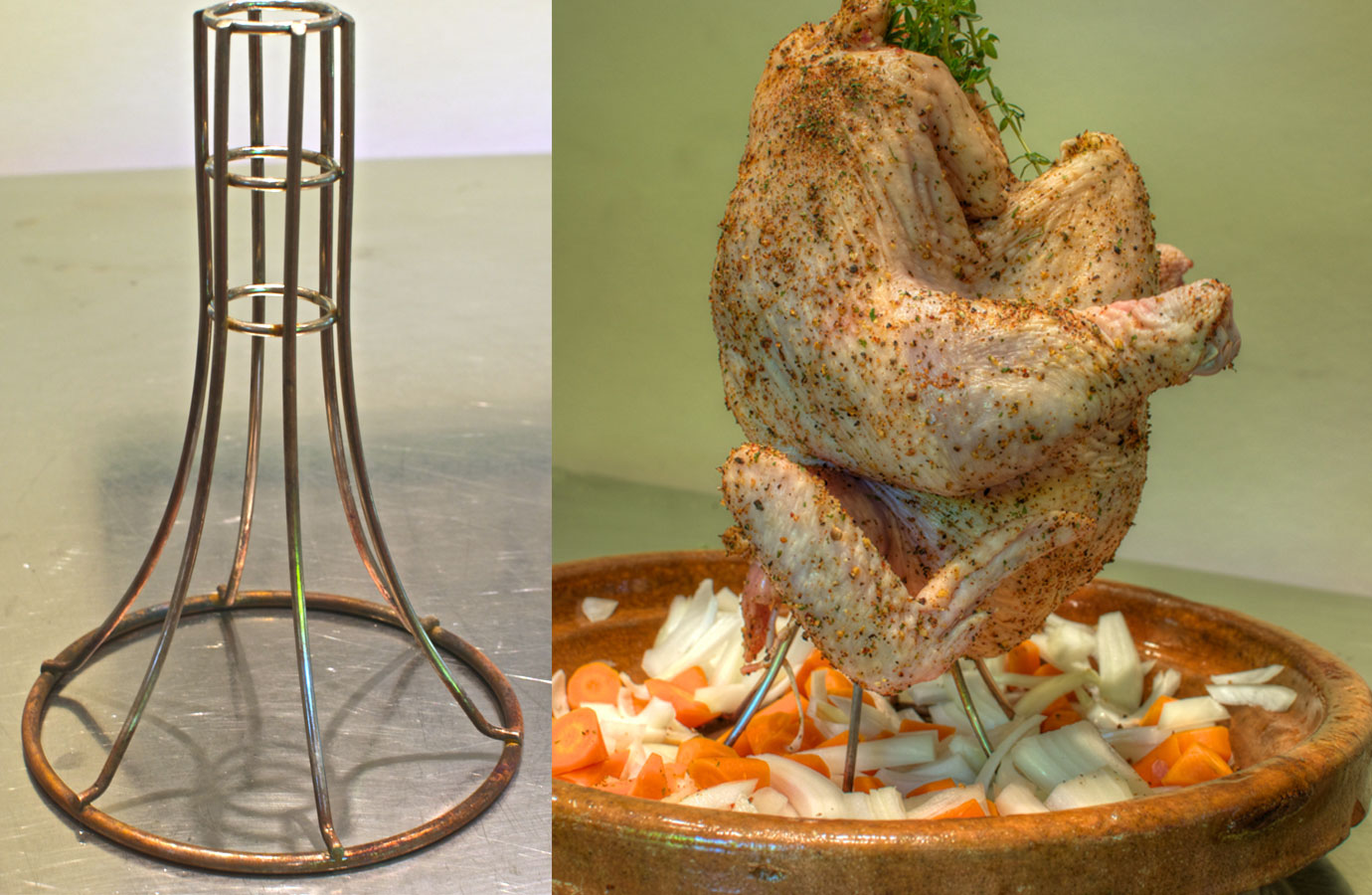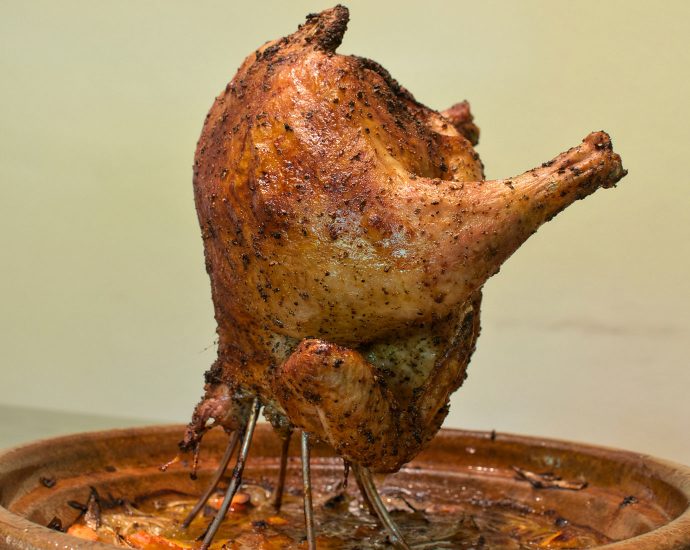Ask any chef, “What’s your favorite meal?” and you’ll hear “roast chicken” an impressive percentage of the time. The fragrance of the golden brown skin crisping as you baste with buttery pan juices, the carrots and onions caramelizing on the bottom of the pan as the bird roasts, and the moist silky texture of the flesh all are irresistible. In the fall or winter a pinot noir or apple cider are great to drink with roast chicken. A crisp sauvignon blanc, rosé or a gingery lemon sparkler are perfect in the spring or summer. A vast array of side dishes work well; roasted potatoes, baked pasta, creamy polenta, winter vegetable gratins, sautéed fresh spinach or spring asparagus are just a few of the possibilities.
About the chicken
An African cookbook in my collection is based on recipes gathered from conversations with local cooks. My favorite one starts, “First catch a chicken…”. Short of that, buy organic, free-range chickens. If you can’t find that quality, don’t cook chicken. I’m not usually so dogmatic, but the difference in taste and texture is dramatic.
Here is a link to a website that demystifies the wording on chicken labels if you are curious about what you’ve been buying and eating.
Different weights work best with different cooking methods. Fryers should weigh 3 to 3.5 pounds, roasters 4 pounds and up. Fowl are older, heavier birds not often seen in American markets. It’s a shame because they make great stock. You can certainly roast a fryer or cut up and fry a roaster, but using the optimal weight chicken for the cooking method makes it easier to get both the skin and the meat correctly cooked at the same time.
It is more economical to buy a whole chicken, and I also have an endless need for bones for stock, so this makes the most sense in my kitchen. However, you might be in a hurry or cooking just for yourself. That’s when buying a whole bird can seem daunting or wasteful and it is a better idea to buy pieces, the breasts or thighs, wings or drumsticks.
Preparing the chicken for the oven
Season the whole chicken inside and out with salt, pepper, and paprika. If you have planned ahead, do this the night before you roast it. Put some branches of thyme in the cavity. Some cooks prefer a sprig of rosemary and a lemon that has been repeatedly pierced with a skewer. The Spice House in Chicago, which also does a large mail order business, makes a blend they call “Back of the Yard Butcher’s Rub.” It is fabulous as a seasoning for roast chicken. I add paprika to their mix for the dusky sweetness it gives the skin.
To truss or not to truss
There is a lot of debate about this. It’s hard to get past the classic picture of a stuffed chicken, trussed and ready for the oven. If you roast by moving the chicken around a lot, from side to side, or breast down and then up, or you are looking for a camera-ready bird that you plan to carve at the table, maybe there’s a rational for trussing the chicken into a compact shape. However, for the best cooking result, THIS IS A MISTAKE. When the legs are not pinned to the body, the heat from the oven moves more efficiently to better penetrate the dark meat. There is no need for a roasting rack either. You are better off choosing a pan or cast iron skillet that’s just a bit larger than the bird, and then resting the chicken on a bed of carrot and onion that has been cut into small dice. The bed of vegetables keeps the bird from sticking to the pan and marvelously flavors the pan juices.
Traditional Instructions
Pre-heat a conventional oven to 450°, a convection oven to 425°. If you can, let the chicken come to room temperature before cooking. Slather it with butter or olive oil, put it on a bed of diced carrot and onion in a roasting pan that’s close to the size of the bird. There are lots of theories about the position of the chicken: breast up, breast down, on one side, then the other. I don’t think it matters that much. After the first 15 minutes, turn a conventional oven down to 375°, a convection oven down to 350°. Rotate the bird every twenty minutes or so, taking the opportunity to baste with the fat and juices accumulating in the pan. Depending on the weight, it will take from an hour to an hour and a half to finish cooking. If you prick the thigh near the joint and the juices run clear, the chicken is done and ready to rest for 10 or 15 minutes, tented with foil, before carving. If you want to precisely test for doneness, take a temperature reading in the thick part of the thigh meat (avoid the bone) with an instant- read thermometer. I recommend pulling the chicken when the temperature reaches 150° to 155° degrees; it will continue to cook as it rests. After making enough roasted chickens, all you will need to do is look at it and poke it a little with your finger to know when it’s done.
Vertical roasting: the best roast chicken in the world

If you love roast chicken, you have to explore this method.
As with a lot of techniques that I use in the kitchen, I’ve been greatly influenced by Asia. In the case of roast chicken, I use the Chinese method of vertical roasting. In order to proceed with the recipe you need to make one relatively inexpensive purchase, a vertical chicken roaster frame. I’ve probably bought 10 of them by now to give away to friends who want the “secret” of this most delicious bird.
It’s easy to buy one online or at hardware stores that sell Big Green Egg accessories. Online the two best options are a Fox Run non-stick vertical poultry roaster ($4.49 from Amazon) or the Big Green Egg Vertical Chicken Roaster ($25.99 from Amazon). The latter is a more durable choice. The important thing is that it is narrow at the top, with a broad strong base because you are going to roast the chicken with the breast down, legs up. Placing the chicken “upside down” is different than you will see on any of the pictures or advertisements for vertical roasters, but it is definitely the way to go. With the legs splayed out and closer to the top, the hottest part of the oven, the dark meat finishes at the same time as the white meat. There is also the added advantage that the drier breast is continually being basted as juices drip down from the legs.
Instructions for vertical roasting
You may need to rearrange the racks in your oven to accommodate a “standing” chicken. Preheat a conventional oven to 375°, a convection oven to 350°. Season the chicken inside and out as you normally do and rub with butter or olive oil. I like to put thyme branches in the cavity. Impale it on the roaster with the legs up. Set the chicken on the frame in a roasting pan surrounded by thinly sliced onions and blanched carrots. I add some dry sherry or wine to the pan and either chicken stock or water, enough to barely cover the vegetables in the bottom. There is no need to baste the chicken while it’s cooking. In my oven (a 25-year-old Garland convection oven) a four-pound chicken takes precisely one hour to cook. Buy the same weight chicken every time (a quarter of a pound either way does not affect things), get to know the cooking time in your oven, and there is no need to poke or take temperatures. You just close the oven door, set the timer, and with no further ado, out comes a fabulously juicy roast chicken with crispy skin and flavorful pan juices.
Day one, eat the roast chicken. Day two, take the remaining chicken off the bone and use it in a pasta dish or salad. Day three, pull apart the frame of the chicken, cover with water or a commercial broth (favorite brand: Swanson) add some fresh onion and carrot and simmer for a half hour or so. This gives authentic flavor to a store bought broth. Strain, chill, skim the fat, and store in the refrigerator or freeze. This broth makes a great base for a soup, a sauce or a rice dish.


I love this, and thanks for including me. Please tell me that I don’t have to go to my least favorite store on earth (the one that starts with a W) to buy the chicken! Maybe a kosher butcher? or halal? or you tell me……
Definitely no need to go to W! A kosher butcher or halal would be perfect. Since Kosher chickens are salted as part of the koshering process, reduce the amount of salt you usually use when you season you bird. Also the chickens sold on Arglye (Vietnamese markets) would work well. They have to be organic to stand up to the vertical roasting process favored by Vietnamese cooks. I’m thrilled you like the site! Cheers, Lisa
Lisa, Congrats on your new website!!!
Hi Lisa,
Fantastic website! Every article is informative and beautifully presented. Thank you for your considerable efforts!
I learned about your new site/blog from a share from Chicago Market –what a well organized and presented site. I have subscribed, and I think will enjoy reading and learning from your techniques. Good Luck!
I am delighted that you are enjoying the first edition of the Cook’s Gazette! Please let me know if you have any questions or further comments. Cheers, Lisa
First test drive of the LG chicken recipe. Bought the vertical roaster and the chicken. Some surgery was required on the bird’s posterior opening to get it down on the vertical rack, but then it fit in my very old Castle stove oven. Bottom line…..slightly underdone but absolutely delicious, juicy and a total win. If spring ever comes I will try this in the Weber kettle. Thanks for a great recipe!
My guess “slightly underdone” means 15 minutes more in the oven. Now you know with a particular weight chicken and your particular stove how much long it will take each time you vertically roast a chicken. I’m so glad you enjoyed1 Cheers, Lisa
I tried the vertical roasting method with a duck. 5.5 lb. duck, 375 f., for 2 hours in a conventional oven. I did it legs down and the results were terrific. Every part of it turned out just perfectly. And just for the hell of it I put 1/2 bottle of ale and about the same amount of water in the pan under the roaster. Can’t hurt, right?
I finally got around to checking your site out. WOW. Love it. Just ordered my chicken stand from Amazon. Can’t wait to try it out.
I’m so glad you enjoyed the site! The spring edition will be out mid May. Cheers, Lisa
How on earth do you get the chicken to fit with it’s legs down. My vertifical roaster opening is probably about 2″ and the bird’s neck is maybe 1″.
Hi. Thanks for writing me. Take a strong pair of scissors or poultry sheers and cut down between the neck bone and the breast bone on both sides to widen the opening. The final results is worth the extra effort at the start. Please let me know how it turns out. Lisa
I cut mine down on the sides a little-fits perfect!!!!
I haven’t cooked a chicken vertically in years. In the past, I’ve cooked it upright. I decided to try it upside down this time. The breast meat was so moist! And, cooking the root veggies with it (I used a 9×13 pyrex) with chicken broth was genius!
Thanks for teaching this old dog a new trick.😊
I’m so glad you enjoyed the chicken! Look for a new edition of the Gazette, out late this week or early next week. It’s about cookbooks. Cheers, Lisa
am trying the upright chicken recipe now-will let u no how it comes out. thanks,Sheila
I am roasting my first standing chicken right now and the thyme is making a wonderful aroma.
I noticed that in your picture you have what it appears to be a clay dish, is that correct?
Yes it’s a clay dish, the bottom to a tangine. I’m so glad you are trying the recipe. Lisa
I’ve been cooking chicken like this for a long time. Now that I have a convection oven, your temperature guidance has helped me turn out the best results ever. I wedge up a lemon and jam most of it along with celery down the cavity without blocking the tube. Coarsely ground pepper and seasoned salt for a rub inside and out. The mirepoix is delightful and enjoyable for days. Thank you!
Say what you want about the nations largest retailer. Where I live in South Carolina, I can get a beautiful Claxton chicken for under three dollars. We eat the chicken for two days, make sandwiches, and I have chicken soup to take to work all week. Buy some shares of stock and Sam Walton’s venture
I have been cooking checking vertically like this but out of my cheapness I use a bundt pan, the bonus is you can add veggies around the chicken. Love your site!
Sweet earth, I’m so glad you are enjoying the site. The bundt pan is a really clever idea! Lisa
I, too, have only roasted chicken vertically, although I haven’t roasted a chicken in a couple of years. Tonight, I originally set the chicken breast-side down on the rack, thinking “juices will baste the breast.” Then, looking at several other recipes (I always bring up two or three to average a cooking time), I turned it around, as they all showed drumsticks down. THEN, I found your recipe and you confirmed my thoughts as per self-basting if turned breast down! So, that’s the way I’m cooking it now, and will know in an hour and a half if this truly is the way to go, although I’m pretty sure you have the right of it!
Let me know how it comes out! Enjoy. Lisa
I cooked this tonite and it was delicious! I have cooked chicken on a vertical rack set in a cast iron skillet for years. But tonite I tried you suggestion of cooking the chicken upside down, legs up. I did truss the legs together. The outcome was just great. Even my picky eater commented that this was usually good. When I do this I put some quartered red potatoes in the pan. After cooking the chicken I remove it from the pan along with the potatoes. Then using the fat and juices in the bottom of the pan I make gravy adding flour and 2 cups of chicken broth. Thank you for your suggestion. I will be using it in the future.
I’m delighted your chicken turned out well! Best wishes, Lisa
Spice House no longer has the specific spice you mention. The closest is Back of the Yard Garlic Pepper Butchers Rub. How close is that to your suggestion?